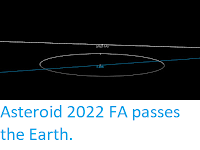Witnesses across much of northern and central France, as well as Belgium, Luxembourg, the Netherlands, Switzerland, southern England, and western Germany, have reported observing a bright fireball slightly before 3.50 am local time (slightly before 1.50 am GMT) on Wednesday 20 April 2022. The fireball is described as having moved from west to east first appearing over the Oise and vanishing over the Ardennes. A fireball is defined as a meteor (shooting star) brighter than the planet Venus. These are typically caused by pieces of rock burning up in the atmosphere, but can be the result of man-made space-junk burning up on re-entry.
The 20 April 2022 fireball meteor seen from Les Églisottes-et-Chalaures. Pierre-Olivier Castille/American Meteor Society.
Objects
of this size probably enter the Earth's atmosphere several times a
year, though unless they do so over populated areas they are unlikely to
be noticed. They are officially described as fireballs if they produce a
light brighter than the planet Venus. The brightness of a meteor is caused by friction with
the Earth's atmosphere, which is typically far greater than that caused
by simple falling, due to the initial trajectory of the object. Such
objects typically eventually explode in an airburst called by the
friction, causing them to vanish as an luminous object. However, this is
not the end of the story as such explosions result in the production of a
number of smaller objects, which fall to the ground under the influence
of gravity (which does not cause the luminescence associated with
friction-induced heating).
Heat map showing areas where sightings of the meteor were reported (warmer colours indicate more sightings), and the
apparent path of the object (blue arrow). American Meteor Society.
These 'dark objects' do not continue along the path
of the original bolide, but neither do they fall directly to the ground,
but rather follow a course determined by the atmospheric currents
(winds) through which the objects pass. Scientists are able to calculate potential trajectories for hypothetical dark
objects derived from meteors using data from weather monitoring services.
See also...


Follow Sciency Thoughts on Facebook.
Follow Sciency Thoughts on Twitter.


.png)



